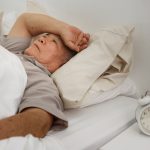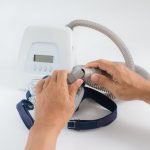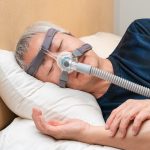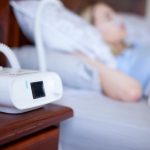Sleep Apnea, Sex and Intimacy: Can CPAP be Sexy?
Posted by Dr. Michael Breus

You know what doesn’t feel sexy? Snoring and gasping for air at night. Neither does feeling exhausted, irritable, depressed or anxious, unfocused, and disconnected from your partner. These are all symptoms and consequences of untreated obstructive sleep apnea.
My patients with OSA wonder and worry about what using CPAP or other sleep apnea treatments might do to their intimate lives. I understand their concern. But the truth is, it is untreated sleep apnea that really undermines intimacy. In addition to the symptoms I laid out above, sleep apnea also contributes directly to sexual problems—with desire and arousal, as well as sexual function—in both men and women.
Treating sleep apnea is a path back into greater intimacy and a more fulfilling sex life.
A lot of men and women don’t know they’re suffering from sleep apnea. The episodes of compromised and interrupted breathing (hypopneas and apneas) are highly disruptive to sleep and health, and contribute to dozens, even hundreds, of micro-awakenings throughout the night. But these brief awakenings often go unremembered and unrecognized by sleepers.
Issues with intimacy between partners, including problems in a couples’ sex life, can be a signal of undiagnosed sleep apnea in one or more partners, especially when intimacy problems occur in conjunction with other symptoms of OSA.
Let’s take a look at how sleep apnea can interfere with sex and intimacy—and how you can make using a CPAP sexy. (For real!)
Sleep apnea is linked to low testosterone and erectile dysfunction
Testosterone is a key hormone for male sex drive (women’s, too), fueling both arousal and sexual function, including erectile function. Testosterone naturally declines with age. From the age of 40 onward, men’s testosterone production drops about 1% per year.
Testosterone production follows daily circadian rhythms, the same bio rhythms that govern sleep-wake cycles. Fragmented sleep has been shown to disrupt the daily rhythm of testosterone production. Studies have shown that testosterone levels are lower in men with OSA, due to sleep disruption and potentially due to other OSA factors, including obesity and reduced blood oxygen levels.
Men with low testosterone may experience a number of sexual issues. Sexual drive and desire, or libido, is suppressed. Men with low testosterone also can experience impotence and erectile dysfunction.
There is a tremendous overlap between men with OSA and men with erectile dysfunction, or ED. Let’s take a quick look at some stats. Studies show:
- As many as 80% of men with OSA have ED. (There’s a range across different research, from slightly below 50% up to 80% or more.)
- For example, this 2009 study found that 69% of men with OSA had ED, compared with 34% of men without ED.
- New research indicates that men with ED are more than twice as likely to have OSA.
For all the evidence that exists of an extremely strong correlation between erectile dysfunction and sleep apnea, scientists don’t yet know precisely what drives this correlation. Low testosterone may be an important factor in raising ED risks for men with OSA. Fatigue, stress and anxiety from the chronic poor sleep of sleep apnea may also contribute to this elevated risk. The good news? Research shows that treating sleep apnea with CPAP leads to improvements in sexual function in men with erectile dysfunction.
Women lose sexual desire and function with sleep apnea
Women with OSA also experience problems with sex drive and their sexual function. The relationship between sleep apnea and sexual dysfunction in women is not as well studied as in men. (That needs to change, ASAP) Nevertheless, there is a body of research showing that sleep apnea has direct, negative effects on women’s sex lives. Studies have found that OSA had a negative impact on many dimensions of women’s sexual experience, function, and behaviour including:
- Arousal and desire
- Frequency of sexual activity
- Lubrication
- Frequency of orgasm, and of sexual fantasies
This study also found that more severe OSA was connected to more intense disruption to women’s sex lives.
Sleep apnea impacts sexual experience for both pre- and post-menopausal women. It may do so for different underlying reasons. A number of studies have shown that both pre- and post-menopausal women with sleep apnea experience reduced desire, arousal and orgasm—and that the severity of OSA affects the degree of sexual dysfunction.
Research that looks specifically at premenopausal women found a significant correlation between severe OSA and low progesterone. Progesterone is a hormone that helps to balance the effects of estrogen. While high levels of progesterone appear to suppress sexual desire, low progesterone can also contribute to sexual dysfunction. Scientists think low progesterone levels triggered by severe OSA may be a cause of reduced arousal in women.
It’s important to know, rates of sleep apnea increase dramatically among women during and after menopause. Research shows 20% of women develop OSA during menopause, and an estimated 47-67% of postmenopausal women have sleep apnea, according to research. Perimenopause and menopause bring about changes to hormone production in women. Fluctuating and declining levels of estrogen and dwindling progesterone of menopause can affect both sexual desire and sexual function. The presence of sleep apnea during menopause may further complicate and hinder women’s sexual lives.
And as with men, women’s sexual desire and function may also be negatively affected by the depression, anxiety, fatigue and fragmented sleep that so often accompanies untreated sleep apnea.
OSA puts a strain on emotional intimacy
Of course, there’s much more to intimacy than sex. Emotional connection, strong communication, physical closeness, a vital sense of appreciation and partnership are all part of real intimacy, and all can suffer when one or more partners has untreated sleep apnea. Let’s take a look at some of the ways OSA undermines the bonds between partners.
Sleep apnea’s snoring create sleeplessness and stress for both partners. The noise—snoring, gasping, snorting, choking—deprives both bed partners of sleep, and contributes to tension and frustration and resentment between partners. Disrupted breathing often drives couples to sleep in separate beds. (I see this constantly in my practice.) Sleeping separately can mean couples lose out on the opportunity for sex, and also the comfort and intimacy of sleeping with a partner.
The impact of one partner’s OSA on the other can go overlooked—but the negative consequences for bed partners of people with OSA and other sleep problems are significant. Research shows that one partner’s sleep problems are linked to a range of serious issues with the other partner’s mental health and relationship satisfaction, including:
- Feelings of unhappiness
- Depressed mood
- Sense of isolation
- Greater dissatisfaction and unhappiness in the relationship
Depression linked to OSA is real—and it interferes with intimacy. I don’t think we talk enough about the depression that so often accompanies untreated sleep apnea. A brand-new study conducted by the CDC evaluated a nationwide sample of adults in the U.S., and found that OSA and its symptoms are strongly associated with major depression, with symptoms that include
- feeling hopeless
- feeling one’s self to be a failure
- exhaustion and a loss of energy that can be profound
- a loss of interest and enthusiasm for life’s activities and passions
- guilt, shame, and harsh self-judgment
- further disruption to sleep
Depression is also linked to lower levels of relationship satisfaction. Research demonstrates a complex dynamic that may sound familiar to those of us in relationships with sleep apnea, sleep deprivation, and depression present. Depression creates stress, isolation, and conflict in relationships, and those fissures in our relationships in turn create more depression. It’s a difficult cycle, one that’s made more complicated when sleep apnea goes untreated.
Poor sleep itself puts distance between couples. OSA robs sleepers and their partners of a healthy, sold night’s rest. Lacking high quality, restorative sleep, isolation and conflict can overshadow and replace intimacy and connection. Researchers at the University of California, Berkeley have shown that sleeping poorly diminishes partners’ gratitude and appreciation for one another, and leaves partners less attuned to one another’s moods, needs, and vulnerabilities. The binding threads of intimacy so often rest in this terrain of relationships—the ability to see one another in the moment, to read each other’s moods and respond with support and compassion. Untreated sleep apnea makes all of this intimate relating between couples more difficult, and less likely to occur.
CPAP can bring sexy back
CPAP is the first line, gold standard treatment for sleep apnea. Decades of scientific research have shown it highly effective at restoring normal breathing, enabling more restful sleep, improving OSA symptoms and reducing the health risks associated with OSA. But for CPAP to work, you’ve got to use it—consistently. A lot of my patients feel anxious about using CPAP and particularly about wearing it in front of their partners. Will they think I look ridiculous? Will this kill my sex life?
Just the opposite, I tell them. Both sex and emotional intimacy improve when people with OSA start using CPAP, according to a body of research. Sleepiness and fatigue are reduced, sex becomes better and more frequent, and partners feel closer to one another.
Here’s what else I tell my patients.
Feeling better is sexy and fun. Treating your OSA has a profound impact on your sleep and health. It’s the path back to achieving restful, restorative sleep, to renewing your energy, focus, and vitality. (At a cellular level, your brain and body are being supplied with more oxygen, thanks to your normalized breathing.) At the same time, treating sleep apnea eases fatigue and anxiety. You can do more with your waking hours, while thinking and feeling more like yourself.
Treating sleep apnea can bring about a fundamental quality of life change, while significantly reducing the health risks associated with untreated OSA, including cardiovascular disease, diabetes, and mood disorders such as major depression. These improvements achieved through CPAP therapy can have a major impact on how you feel about your own sexuality, and how you relate to your partner, physically and emotionally. CPAP also has a direct impact on sexual function. For example, this 2018 study found CPAP improves sexual satisfaction and erectile function. CPAP treatment also improves partners’ quality of life. When one partner’s OSA gets treated effectively, both partners feel better, more optimistic, energetic, and engaged with life and each other.
Supporting each other is sexy and fun. The stress, sleeplessness and noise of OSA puts emotional and physical distance between partners. Treating OSA can bring couples closer together. When they have their partners’ support, CPAP users feel more motivated to keep using the therapy. Studies show they use their CPAP more consistently and for longer stretches of time during the night. Partners can play a critical role in helping those with OSA acclimate to using the device, in part by reassuring them over their concerns—Do I look weird? Will you still want to sleep with me?
When one person has OSA, both partners suffer. It’s a problem you share. I encourage my patients with OSA who are in relationships to team up with their partners for the solution. Couples who approach treating one partner’s OSA with a we’re in this together mindset will find greater success in the therapy, and re-connect with each other in the process.
Getting out of the “sex at bedtime routine” is sexy and fun. It might surprise you to hear, but from a biological standpoint, bedtime is the absolute worst time to have sex. Our body’s daily bio rhythms regulate the hormones that fuel sexual desire and function, including testosterone. Testosterone, a driver of sexual arousal in both men and women, hits its lowest levels at night, right around most people’s bedtime. And depending on your individual biological chronotype, sex at night can actually keep you awake, not help you drift off to sleep. (To find out your chronotype, you can take my short quiz, here.)
When is testosterone highest? First thing in the morning.
Sex at bedtime is a habit of convenience. It’s actually morning when the body’s daily desire rhythm is at its peak. Want to recharge your intimacy and implement some new sexual routines along with that CPAP routine you’re incorporating into your life? Try morning sex. Cuddle at night, use your CPAP consistently overnight, and you’ll feel more rested and ready for sexual intimacy in the morning.
Sweet Dreams,
Michael J. Breus, PhD, DABSM
The Sleep Doctor™
www.thesleepdoctor.com












